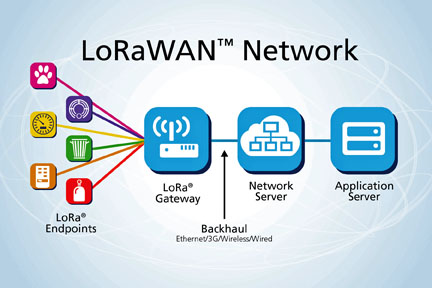LoRa is a wireless technology developed for the low-power wide-area networks (LPWANs) used in machine-to-machine (M2M) and Internet of Things (IoT) applications. The technology offers a very compelling mix of long-range, low-power consumption, and secure data transmission and is gaining significant traction in IoT networks being deployed by wireless network operators.
A network based on LoRa wireless technology can provide coverage that is greater in range than existing cellular networks. Many mobile network operators have chosen to complement their existing cellular/wireless networks with a LPWAN based on LoRa technology because it is easy to plug into their existing infrastructure and allows them to offer their customers a solution to serve more IoT battery-operated applications.
The LoRa technology was originally developed by Semtech, but is now coordinated by the 170-member LoRa Alliance, a non-profit organization focused on standardizing the technology for IoT and creating a strong ecosystem to scale the technology. To date, the alliance has developed a global LPWAN specification, known as LoRaWAN, to help standardize and foster the adoption of these networks which in turn enable new IoT, M2M, smart city, and industrial applications.
LoRaWAN networks primarily use the unlicensed ISM band (either 868 MHz or 900 MHz) to communicate over distances of 15 to 30 miles in rural or other unobstructed environments. For dense urban or indoor applications, LoRaWAN offers distances of up to 1 to 2 miles. LoRaWAN data rates range from 300 bits per second to 50 kilobits per second. The sensors require very little energy to operate and the specification requires AES128 encryption — providing a high level of security.
A network based on the LoRaWAN specification typically consists of several elements:
- End points (sensors): The endpoints are the elements of the LoRa network where sensing or control is undertaken and are normally remotely located.
- LoRa gateway: The gateway receives the communications from the LoRa endpoints and then aggregates the data onto a backhaul connection. This backhaul link can be Ethernet, cellular, or any other wired or wireless telecommunications link that enables the gateway to connect to network LoRa servers using standard TCP/IP connections. This use of a standard protocol provides the ultimate backhaul interoperability across both public and private networks. Because LoRa network and cellular networks are similar, LoRa gateways are often co-located with a cellular base station and consume spare capacity on the backhaul network.
- Server: The LoRa network server knows the configuration and manages the network. It acts to eliminate duplicate packets, schedules acknowledgement, manages security, and adapts data rates.
- Application Server: Manages payload security and performs analysis to use sensor data.

Fig. 1: The LoRa network architecture.
In the LoRa network’s architecture, the end points are typically in a star-of-stars topology with gateways forming a transparent bridge. These relay messages between end-devices and a central network server in the backend. Communication to end-point nodes is generally bi-directional, but it is also possible to support multicast operation, which is useful for features such as software upgrades or other mass-distribution messages.
LoRa chips and modules are available from a number of manufactures, including Semtech, Microchip, Hope RF, and RF Solutions. Example transceivers include the Semtech SX1301 multi-band gateway transceiver and SX1272 end-node transceiver. The SX1301 digital baseband chip is a DSP offering breakthrough gateway capabilities in the ISM bands. It yields up to -142.5 dBm sensitivity when using the SX1257 Tx/Rx front-end.
The SX1272 end-node transceiver uses a patented LoRa modulation technique and can achieve a sensitivity of over -137 dBm using a low-cost crystal and bill of materials. The chip includes a +20 dBm power amplifier and its bit rate is programmable up to 300 kbits/s.
Advertisement
Learn more about Semtech





